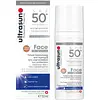Ultra Violette Fave Fluid SPF 50+ Ultralight Skinscreen Versus Ultrasun Face Anti-Pigmentation Tinted SPF 50+
What's inside
What's inside
 Key Ingredients
Key Ingredients

 Benefits
Benefits

 Concerns
Concerns

 Ingredients Side-by-side
Ingredients Side-by-side

Water
Skin ConditioningIsoamyl Laurate
EmollientAlcohol Denat.
AntimicrobialPolyester-8
Skin ConditioningBis-Ethylhexyloxyphenol Methoxyphenyl Triazine
Skin ConditioningPhenylbenzimidazole Sulfonic Acid
UV AbsorberButyl Methoxydibenzoylmethane
UV AbsorberPhenyl Trimethicone
Skin ConditioningCaprylyl Methicone
Skin ConditioningPropanediol
SolventAluminum Starch Octenylsuccinate
AbsorbentEthylhexyl Triazone
UV AbsorberSodium Hydroxide
BufferingAcrylates/C12-22 Alkyl Methacrylate Copolymer
PEG-40 Hydrogenated Castor Oil
EmulsifyingHydroxyacetophenone
AntioxidantAcrylates Copolymer
Phenoxyethanol
PreservativeNiacinamide
SmoothingDisodium Lauriminodipropionate Tocopheryl Phosphates
CleansingHydrolyzed Adansonia Digitata Seed Extract
Hydrolyzed Soy Protein
HumectantRice Amino Acids
Skin ConditioningProline
Skin ConditioningArginine
MaskingCoco-Glucoside
CleansingDisodium Lauryl Sulfosuccinate
CleansingAscorbyl Glucoside
AntioxidantHydroxystearic Acid
CleansingWater, Isoamyl Laurate, Alcohol Denat., Polyester-8, Bis-Ethylhexyloxyphenol Methoxyphenyl Triazine, Phenylbenzimidazole Sulfonic Acid, Butyl Methoxydibenzoylmethane, Phenyl Trimethicone, Caprylyl Methicone, Propanediol, Aluminum Starch Octenylsuccinate, Ethylhexyl Triazone, Sodium Hydroxide, Acrylates/C12-22 Alkyl Methacrylate Copolymer, PEG-40 Hydrogenated Castor Oil, Hydroxyacetophenone, Acrylates Copolymer, Phenoxyethanol, Niacinamide, Disodium Lauriminodipropionate Tocopheryl Phosphates, Hydrolyzed Adansonia Digitata Seed Extract, Hydrolyzed Soy Protein, Rice Amino Acids, Proline, Arginine, Coco-Glucoside, Disodium Lauryl Sulfosuccinate, Ascorbyl Glucoside, Hydroxystearic Acid
Water
Skin ConditioningCaprylic/Capric Triglyceride
MaskingPentylene Glycol
Skin ConditioningGlycerin
HumectantMethylene Bis-Benzotriazolyl Tetramethylbutylphenol
UV FilterTitanium Dioxide
Cosmetic ColorantEthylhexyl Salicylate
UV AbsorberBis-Ethylhexyloxyphenol Methoxyphenyl Triazine
Skin ConditioningC12-15 Alkyl Benzoate
AntimicrobialDiethylamino Hydroxybenzoyl Hexyl Benzoate
UV FilterEthylhexyl Triazone
UV AbsorberAscorbyl Glucoside
AntioxidantBentonite
AbsorbentSqualane
EmollientCocoglycerides
EmollientHydrogenated Phosphatidylcholine
EmulsifyingC8-22 Alkyl Acrylates/Methacrylic Acid Crosspolymer
Hexylresorcinol
AntimicrobialEctoin
Skin ConditioningDecyl Glucoside
CleansingEthyl Linoleate
EmollientSilica
AbrasiveXanthan Gum
EmulsifyingVitis Vinifera Seed Extract
AntimicrobialSodium Citrate
BufferingSodium Hydroxide
BufferingPropyl Alcohol
SolventCetyl Phosphate
EmulsifyingAlcohol
AntimicrobialPropylene Glycol
HumectantCitric Acid
BufferingLecithin
EmollientTocopheryl Acetate
AntioxidantAscorbyl Tetraisopalmitate
AntioxidantTocopherol
AntioxidantDiisopropyl Adipate
EmollientUbiquinone
AntioxidantMica
Cosmetic ColorantCI 77492
Cosmetic ColorantCI 77491
Cosmetic ColorantCI 77891
Cosmetic ColorantCI 77499
Cosmetic ColorantWater, Caprylic/Capric Triglyceride, Pentylene Glycol, Glycerin, Methylene Bis-Benzotriazolyl Tetramethylbutylphenol, Titanium Dioxide, Ethylhexyl Salicylate, Bis-Ethylhexyloxyphenol Methoxyphenyl Triazine, C12-15 Alkyl Benzoate, Diethylamino Hydroxybenzoyl Hexyl Benzoate, Ethylhexyl Triazone, Ascorbyl Glucoside, Bentonite, Squalane, Cocoglycerides, Hydrogenated Phosphatidylcholine, C8-22 Alkyl Acrylates/Methacrylic Acid Crosspolymer, Hexylresorcinol, Ectoin, Decyl Glucoside, Ethyl Linoleate, Silica, Xanthan Gum, Vitis Vinifera Seed Extract, Sodium Citrate, Sodium Hydroxide, Propyl Alcohol, Cetyl Phosphate, Alcohol, Propylene Glycol, Citric Acid, Lecithin, Tocopheryl Acetate, Ascorbyl Tetraisopalmitate, Tocopherol, Diisopropyl Adipate, Ubiquinone, Mica, CI 77492, CI 77491, CI 77891, CI 77499
 Reviews
Reviews

Ingredients Explained
These ingredients are found in both products.
Ingredients higher up in an ingredient list are typically present in a larger amount.
Ascorbyl Glucoside is a stable form of Vitamin C. It is created by combining glucose from starch.
When applied to skin, Ascorbyl Glucoside turns into Ascorbic Acid.
Ascorbyl Glucoside is an antioxidant. Antioxidants help fight free-radicals, or molecules that may damage skin cells.
It can help to reduce redness, improve skin texture, reduce the effects of aging, reduce the visibility of dark spots, and brighten skin.
Read more about other types of Vitamin C:
Learn more about Ascorbyl GlucosideYou might know this ingredient as Tinosorb S or Bemotrizinol. It is a UV filter that covers both UVA and UVB rays.
This ingredient has two peak UV absorption peaks ( 310 and 340 nm) and is able to absorb both UV-A and UV-B rays. This ingredient works by preventing UV rays from reaching and damaging your skin.
On top of that - it is highly photostable and helps prevent the photodegration of other sunscreen ingredients such as avobenzone.
Tinosorb S is allowed in the EU, Australia, and Asia. It is close to being approved by the FDA and we'll hopefully get this ingredient in the U.S. by late 2025.
Fun fact: Tinosorb S is the most effective UV absorber at maximum concentration (measured by SPF) permitted in the EU.
This ingredient is oil-soluble, so your oil-cleansers will take this right off at night.
Learn more about Bis-Ethylhexyloxyphenol Methoxyphenyl TriazineEthylhexyl Triazone is a modern chemical sunscreen that protects from UV-B radiation.
It is the most effective of existing UV-B filters, as it provides the highest level of photo-stable absorption. It protects from the entire UV-B range (280 to 320nm), with it's highest level of protection at 314nm.
Ethylhexyl Triazone is oil soluble, oderless and colorless, which mean it is able to be incorporated into a variety of different formulations.
It is not currently available within the United States due to slow changing FDA regulations. Outside of the US, it is used in formulations at concentrations up to 5%.
Learn more about Ethylhexyl TriazoneSodium Hydroxide is also known as lye or caustic soda. It is used to adjust the pH of products; many ingredients require a specific pH to be effective.
In small amounts, sodium hydroxide is considered safe to use. However, large amounts may cause chemical burns due to its high alkaline.
Your skin has a natural pH and acid mantle. This acid mantle helps prevent harmful bacteria from breaking through. The acid mantle also helps keep your skin hydrated.
"Alkaline" refers to a high pH level. A low pH level would be considered acidic.
Learn more about Sodium HydroxideWater. It's the most common cosmetic ingredient of all. You'll usually see it at the top of ingredient lists, meaning that it makes up the largest part of the product.
So why is it so popular? Water most often acts as a solvent - this means that it helps dissolve other ingredients into the formulation.
You'll also recognize water as that liquid we all need to stay alive. If you see this, drink a glass of water. Stay hydrated!
Learn more about Water